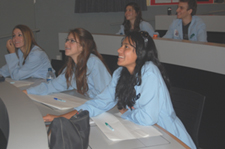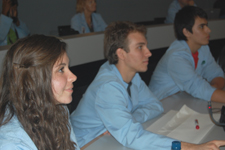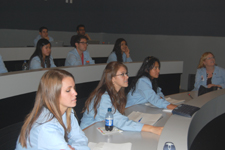Media Contact
Al Bravo
602-827-2022
Release Date
July 22, 2009
 Imagine cutting years off the time it takes to train physicians. That is, having teen-agers begin medical school courses right out of high school.
Imagine cutting years off the time it takes to train physicians. That is, having teen-agers begin medical school courses right out of high school.
That experiment in medical education has begun in downtown Phoenix and in Tucson.
The Phoenix-based T-Health Institute, part of the Arizona Telemedicine Program at The University of Arizona College of Medicine in Tucson, is completing the Sir William Osler High School Summer Fellowship Program this week. Nine high schoolers from Arizona and California are completing the program, having spent six intensive weeks of instruction, including a sampling of medical school courses, as a test to the accelerated training idea.
 “We wanted to see if our high school students, without the benefit of medical school prerequisite courses, could actually handle medical school-type courses,” said Ronald S. Weinstein, MD, founding director of the award-winning Arizona Telemedicine Program. “Even the premise that current prerequisite courses for medical school admission, such as physics, should come first, before medical school, should be open to question.”
“We wanted to see if our high school students, without the benefit of medical school prerequisite courses, could actually handle medical school-type courses,” said Ronald S. Weinstein, MD, founding director of the award-winning Arizona Telemedicine Program. “Even the premise that current prerequisite courses for medical school admission, such as physics, should come first, before medical school, should be open to question.”
Currently, many medical schools require a long list of premedical science courses before students are even considered for admission. Applicants must have at least a bachelor’s degree, meaning they will have spent four or five years in college before their first medical school class.
Consolidating the undergraduate requirements with medical school could take at least two years off the current timeline, saving students thousands of the dollars in tuition costs alone.
 "We could graduate medical students more quickly, helping to fill the gap of needed healthcare professionals if they do not have to go through eight years of undergraduate and medical schooling," said Gail P. Barker, PhD, director of the T-Health Institute.
"We could graduate medical students more quickly, helping to fill the gap of needed healthcare professionals if they do not have to go through eight years of undergraduate and medical schooling," said Gail P. Barker, PhD, director of the T-Health Institute.
The T-Health Institute invited a group of high school students as young as 16 to participate based on grades and personal interviews. The Osler Fellows studied the nature of disease, being taught by medical school faculty members.
The classes were designed to simulate medical school classes and laboratories. The last day of the six-week program, Wednesday, the high school students are giving individual presentations on specific diseases they had studied.
“This program is amazing,” said Paula Arteaga, a senior at Cienega High School in Vail. “It introduced me to a lot things that I had no idea even existed, a lot of terms that I am going to have to learn. It’s a great experience.”
“This program was very important to me because I have been pursuing a medical career for the last two or three years, ever since I got into high school,” said Nick Galluzzo, a senior at East Valley Academy in Mesa. “Getting into this program really showed me the pathology side of medicine. It really opened my eyes to all the science that has to go into it.”
Anna R. Graham, MD, a faculty member for the summer program and a Life Time Educator Award winner at The University of Arizona College of Medicine, has seen that kind of response first hand.
“There is always a special joy to be involved with students in their first encounter with new information,” Dr. Graham said. “Our students’ enthusiasm and energy were contagious, and we are delighted with the experience.”
Medical school admission requirements are an important issue for the Arizona Telemedicine Program, which has support from the state to bring health-care services to rural communities with shortages of health-care professionals.
"The issues are complicated," said Dr. Weinstein, a national expert in medical education. "However, we needed to see if we can streamline the education of future rural practitioners. Something needs to be done to reduce the years of training and expense of getting a medical education if we are going to address a number of critical rural health issues."
In his career, Dr. Weinstein has chaired medical school departments and won awards for research and education. In his 20s, while a pathology resident at the Massachusetts General Hospital in Boston, Dr. Weinstein became the youngest National Institutes of Health-funded laboratory director of a major Harvard research laboratory. In 1997, he was the first medical doctor to receive the UA College of Medicine’s Basic Science educator-of-the-year lifetime award. Dr. Weinstein also has received the American Telemedicine Association’s President’s Leadership Award, the most prestigious individual award in the field of telemedicine.
"The medical education community has underestimated the capabilities of high school students to understand disease processes," says Margaret Briehl, PhD, a UA professor of pathology and cancer researcher who taught in the program. “Our faculty members were genuinely inspired by these high school students’ performances!”
The program is named for Sir William Osler, a professor of medicine at Johns Hopkins Medical School in Baltimore, who is credited with creating the basic medical school curriculum model that has been used for a century.
So, did any of the students say they were prepared to enter medical school while still in their teens?
Arteaga said, “Yeah, I think I would because I’ve seen a part of it and what it could be so I think I would be ready.”
# # #